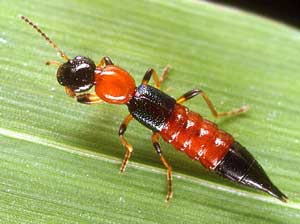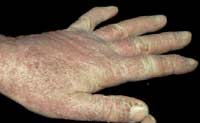Contact Dermatitis Caused by Insects: A Growing Concern
Contact dermatitis caused by insects was previously common in the last months of the year. However, in recent years, the condition has not appeared in “waves” but has been sporadic throughout the year. At this time, during the transitional weather period with unusual changes, the risk of this condition’s occurrence is quite high and difficult to prevent…
Which Insects Cause This Condition?
 |
|
Paederus – Scientific Name |
To date, we have not accurately identified the specific insects that cause this condition. Some authors suggest that the cause of insect contact dermatitis (ICD) may be related to Paederus ants (also known as soldier ants), which belong to the Staphylinidae family. There are nearly 20,000 different species, with common types including P. literalis, P. fuscipes, and P. caligatus. These insects thrive in tropical, humid regions.
Insects often hide in edges of rice fields, under piles of leftover materials, or in garbage areas. When heavy rains flood their habitats, they may enter homes attracted by light and come into contact with household items such as towels, bath linens, bedding, and clothing, causing ICD for those using these items.
As a result, the condition tends to appear during the rainy season, especially after heavy downpours. Patients often report sudden burning sensations on their skin upon waking (over 60%), with more than 70% of cases occurring among those working under bright lights in offices or schools. The burning sensation usually appears on exposed skin areas such as the face, neck, arms, and legs, but can also be scattered across the body or in skin folds.
There have been spikes in cases of ICD in Hanoi, with as many as 46 patients presenting on a single day and a total of 181 (9.8%) out of 1,829 patients examined at the Hanoi Dermatology Hospital within 10 days. In some months, there have been 1,201 (20.4%) cases of contact dermatitis among a total of 5,886 patients, with the condition occurring in waves, predominantly in the suburban districts of Hanoi.
Treatment Methods for Dermatitis
Initially, the lesions appear as long red patches resembling scratches or abrasions, which can vary in size. After a few hours or a day, blisters may develop in the center of the red patches. These blisters can appear as round, oval, or elongated areas that look like something hard has pressed against the skin.
 |
|
Dermatitis |
Some patients may have symmetrical lesions in major skin folds such as the backs of the knees, elbows, groin, armpits, and neck. In loose tissue areas, such as around the eyes, armpits, and groin, the lesions may be more swollen, causing significant discomfort and pain. Initially, the symptoms may only include burning sensations, but they can become painful if accompanied by infection. Patients may experience mild fever, but high fever is rare. With the above skin symptoms, prompt treatment is essential; the condition typically resolves within 7 to 10 days and usually does not leave scars unless an infection occurs.
Treatment methods include rinsing the affected area with a saline solution (0.9%, which can be purchased at pharmacies or made at home) for 5-10 minutes at a time, 3-4 times a day. If symptoms do not improve, it is necessary to consult a dermatologist for timely treatment.
Soothing and anti-irritant medications can be used in the early stages, where redness and burning are present, such as Jarish solution, boric acid solution, water-based lotion, tetra-pred lotion, zinc oil, or corticosteroid creams. If there is an infection (such as blistering), treatments may include methylene blue solutions and antibiotic ointments (such as Bactroban, Fucidin, Foban, Gentamicin). Systemic medications may include antihistamines, antibiotics for infections, pain relievers, and antipyretics if fever and infection are present.
Prevention Measures
Windows and doors can be fitted with mosquito and insect screens. When working under lights and fans, avoid swatting or brushing off any sensations on the skin.
Before going to bed, clean the bed linens and blankets thoroughly, preferably using a damp cloth to remove any insect residues that may have fallen onto them.
Carefully check towels and personal items before bathing.
If any symptoms suggestive of the condition arise, it is important to consult dermatology specialists at institutions such as the Vietnam Dermatology Institute, Hanoi Dermatology Hospital, Ho Chi Minh City Dermatology Hospital, and other hospitals with dermatology clinics for timely examination, consultation, and treatment.


















































